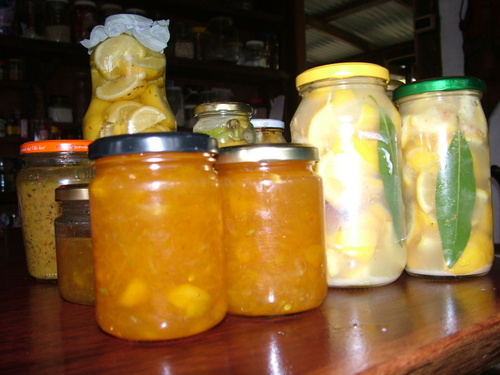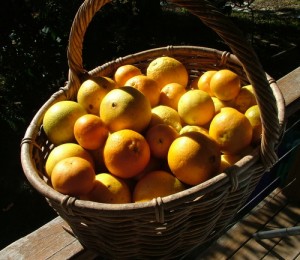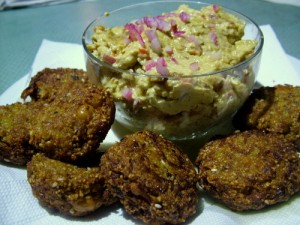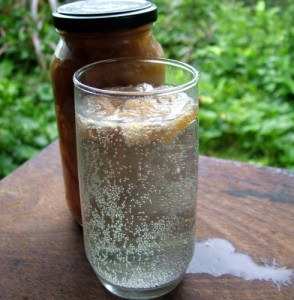All in about an hour. I couldn’t bear the amount of citrus sitting around so I found an hour this morning to make preserved lemons (on the right), lime pickles (back left), lemon cleaning vinegar (at the back), lemon vinegar (tall bottle), and at the front, kumquat marmalade.
Preserved lemons are ridiculously easy and fast, and they’re one of my pantry essentials. A little finely chopped in couscous, marinades, tagines, savoury pancakes, yum. Lime pickles are wonderful with curries or dhal, or, in a very different direction, with cheese on crackers or a good sourdough. Lemon cleaning vinegar is my standard (and just about only) cleaning product. This time of year I fill jars with lemon peel and pour over cleaning vinegar (bottom shelf in the supermarket). It goes in the bucket for floor mopping, in a spray bottle for the stove and shower, direct onto a sponge for disinfecting. It’s really effective, cheap, safe and smells wonderful.
The tall bottle is an experiment. I found that last year’s cleaning vinegar had grown a “mother”. This is a jelly-like layer on top that has the live acetic acid bacteria (a good bacteria) that makes vinegar.
I did a bit of research and found you can add the mother to basically anything alcoholic to make vinegar. I’ve put a bit into some nettle wine that is a bit too “green” tasting to be really nice, and a bit into some home brew bottled about five years ago to make malt vinegar. But I’ve also put a bit into a big jar of just lemons cut into quarters and covered with water. I’m hoping I can skip the alcohol making stage and turn it into lemon cleaning vinegar. The lemons are quite sweet and would, I think, go alcoholic on their own. The top of the bottle has some fine cloth held on with a rubber band so it lets air in and out. So we’ll see what happens!
And kumquat marmalade. Not much else you can really do with kumquats, but they do make the very best marmalade, and though we don’t eat a lot of jam, it makes a good gift.
My Kumquat Marmalade Recipe
I go for simple and quick every time. So my method is:
- Put some jars and their lids on to sterilize by pressure cooking for 10 minutes or boiling for 20. The sugar in jam preserves it from nasty bacteria but sterilizing the jars stops it going mouldy on top.
- Slice the kumquats into fine rings in the food processor with its slicing blade. You can also put some good music on and slice them by hand with a sharp knife, which is slow but at least you can remove seeds as you go which does save you having to fish the seeds out later.
- Weigh them, and add an equal weight of water. (If you haven’t got scales, it’s about two thirds of a cup of water to every cup of sliced kumquats).
- Boil in a big pot for ten minutes or so until the rinds are well softened.
- Add an equal weight to the original raw kumquat weight in sugar. (Ie for a kilo of kumquats, add a kilo of sugar). Raw sugar works fine but will give you darker coloured marmalade.
- Next bit is the tricky bit. Stir in the sugar and the mix should clear and the seeds will float (sort of). Use a spoon to fish out as many of the seeds as you can. ( This is the price you pay for using the food processor to slice!)
- Keep at a nice steady boil, stirring occasionally to stop it sticking, till it turns to jam. How do you tell? Take a teaspoonful out every so often and test it on a cold plate. (Be careful not to take it too far or it turns to toffee – it stiffens up as it cools.) This morning’s batch took less than 10 minutes to turn, but it depends on the amount of pectin in the fruit and that varies. It can take up to half an hour.
- Carefully, carefully (hot jam is one of the worst kinds of burns) pour it into hot jars. Fill the jars to the very top. Wipe the rim with a clean cloth or paper and put the lids on straight away.
Wonderful on good sourdough toast (of course) but also good in jam tarts, or as part of a cheese platter. Or, best of all, with a nice arty label as a gift.





So many great ideas here!
Another idea for kumquats (although more expensive than jam) is to preserve them in brandy. You need to add some sugar too and ideally leave it for a year. The result is a kumquat brandy that can be served neat on is perfect for use in traditional christmas/fruit cakes. Or as a gift too 🙂
It is the season for kumquat jam, and liquours.
I just blog posted about it too.
http://gardengoddess246.blogspot.com.au/
I will definitely be trying the lemon cleaning vinegar, we just use essential oils in ours and that can be expensive.
Oh that’s a bit exciting about your mother. I haven’t delved into vinegars yet, and kombucha for me was a bit of a flop, (that had a similar scoby to your vinegar.) Will play more though.
For the cleaning solution, in previous post you soaked the skins in methylated spirits, but in this one just vinegar. I’m about to make my first cleaning solution. Why the difference? I am assuming it works just as well with lime skins?
Hi Sandra, I’ve never tried lime skins, but I assume it would. It works with orange skins. The idea is just the citrus oils in the skin dissolved in a carrier. I’ve used both vinegar and methylated spirits and I like both of them. Metho is just alcohol with addititves to stop people drinking it, so it’s not taxed so it’s cheap. Vinegar is just alcohol fermented one step further. I think the metho-citrus one dissolves the citrus oil a bit faster and attacks grease a bit more, the vinegar-citrus one I like better for benchtops and surfaces that get food straight on them (as in when I knead bread or roll pastry). I seem to be making the vinegar one more often these days.
Thanks for the Kumquat receipe Linda, but think in future will cut & remove the seeds before slicing fruit, mine still have quite a lot in the jars.
Pingback:Davidson Plum Jam
Pingback:You don’t use antibacterial wipes do you. Tell me you don’t.